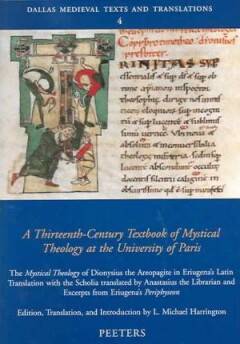
- Afhalen na 1 uur in een winkel met voorraad
- Gratis thuislevering in België vanaf € 30
- Ruim aanbod met 7 miljoen producten
- Afhalen na 1 uur in een winkel met voorraad
- Gratis thuislevering in België vanaf € 30
- Ruim aanbod met 7 miljoen producten
Zoeken
A Thirteenth-Century Textbook of Mystical Theology at the University of Paris
The Mystical Theology of Dionysius the Aeropagite in Eriugena's Latin Translation with the Scholia Translated by Anastasius the Librarian and Excerpts from Eriugena's Periphyseon
LM Harrington
€ 30,00
+ 60 punten
Omschrijving
The luminaries of late thirteenth-century Europe took great interest in the mysterious fifth-century author known as Dionysius the Areopagite. They typically read Dionysius not in the original Greek, but in a Latin edition prepared sometime in the middle of the thirteenth century. This edition, which appeared first in Paris and later circulated all over Western Europe, was no mere translation. In addition to the famous translation made by Eriugena in the ninth century, it contained translations of scholia on the Dionysian texts made by Anastasius the Librarian, alternative readings provided by Anastasius and other Latin readers, as well as excerpts from Eriugena's own theological masterwork, the Periphyseon. University scholars such as Albert the Great and Thomas Aquinas thus learned Dionysian mystical theology not only from his text, but from the seven-hundred year interpretive tradition that literally surrounded it on the page.
Specificaties
Betrokkenen
- Auteur(s):
- Uitgeverij:
Inhoud
- Aantal bladzijden:
- 120
- Taal:
- Engels
- Reeks:
- Reeksnummer:
- nr. 4
Eigenschappen
- Productcode (EAN):
- 9789042913943
- Verschijningsdatum:
- 9/03/2004
- Uitvoering:
- Paperback
- Formaat:
- Trade paperback (VS)
- Afmetingen:
- 170 mm x 239 mm
- Gewicht:
- 276 g

Alleen bij Standaard Boekhandel
+ 60 punten op je klantenkaart van Standaard Boekhandel
Beoordelingen
We publiceren alleen reviews die voldoen aan de voorwaarden voor reviews. Bekijk onze voorwaarden voor reviews.











